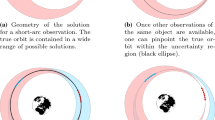Abstract
While the evolution of state uncertainties from Gaussian to non-Gaussian is well understood in geocentric orbits, the only data product made publicly available by the United States Space Force, the Two-Line Element, does not include state uncertainties at all. With a new international focus on cislunar space situational awareness, it is useful to determine how this complex dynamical environment influences trajectory uncertainties and the resultant implications for data association, orbit determination, and force model algorithms. This paper utilizes a new tensor eigenpair measure of nonlinearity (TEMoN) to quantify the nonlinearity of gravitational forces in the cislunar regime. This measure is then compared with various characterizations of Gaussian distributions to determine the value of TEMoN at which trajectory uncertainties become non-Gaussian. This novel advancement combines the cumulative effect of time and physical location of the trajectory into one value. The result is a predictive method that obviates highly parameterized Monte Carlo runs, and allows an objective assessment of how sensor tasking cadence, measurement uncertainty, and force model selection can be balanced to enable nascent cislunar space situational awareness capabilities with legacy space surveillance network assets.










Similar content being viewed by others
References
Alfriend, K.T., Park, I.: When does the uncertainty become non-gaussian. In: Advanced Maui Optical and Space Surveillance Technologies Conference, pp. 46, (2016)
Bader, B.W., Kolda, T.G., et al.: Tensor toolbox for matlab, version 2.2, (2008)
Bates, D.M., Watts, D.G.: Relative curvature measures of nonlinearity. J. R. Stat. Soc. Ser. B (Methodological) 42(1), 1–16 (1980). https://doi.org/10.1111/j.2517-6161.1980.tb01094.x
Cain, M.K., Zhang, Z., Yuan, K.-H.: Univariate and multivariate skewness and kurtosis for measuring nonnormality: prevalence, influence and estimation. Behav. Res. Methods 49(5), 1716–1735 (2017). https://doi.org/10.3758/s13428-016-0814-1
Chow II, C.C.: Autonomous interplanetary constellation design. PhD thesis, University of Southern California (2012)
DeMars, K.J., Bishop, R.H., Jah, M.K.: A splitting gaussian mixture method for the propagation of uncertainty in orbital mechanics. Spacefl. Mech. 140, 1419–1438 (2011)
DeMars, K.J., Bishop, R.H., Jah, M.K.: Entropy-based approach for uncertainty propagation of nonlinear dynamical systems. J. Guidance Control Dyn. 36(4), 1047–1057 (2013). https://doi.org/10.2514/1.58987
DeMars, K.J.: Nonlinear orbit uncertainty prediction and rectification for space situational awareness. PhD thesis, University of Texas at Austin (2010)
Doedel, E.J., Romanov, V.A., Paffenroth, R.C., Keller, H.B., Dichmann, D.J., Galán-Vioque, J., Vanderbauwhede, A.: Elemental periodic orbits associated with the libration points in the circular restricted 3-body problem. Int. J. Bifurc. Chaos 17(08), 2625–2677 (2007). https://doi.org/10.1142/S0218127407018671
Horwood, J.T., Aristoff, J.M., Singh, N., Poore, A.B., Hejduk, M.D.: Beyond covariance realism: a new metric for uncertainty realism. In: O. E. Drummond, (ed.), Signal and Data Processing of Small Targets 2014, vol. 9092, p. 90920F. International Society for Optics and Photonics, (2014). https://doi.org/10.1117/12.2054268
Jenson, E.L., Scheeres, D.J.: Semianalytical measures of nonlinearity based on tensor eigenpairs. J. Guid. Control Dyn. 46(4), 638–653 (2023). https://doi.org/10.2514/1.G006760
Julier, S., Uhlmann, J., Durrant-Whyte, H.F.: A new method for the nonlinear transformation of means and covariances in filters and estimators. IEEE Trans. Autom. Control 45(3), 477–482 (2000). https://doi.org/10.1109/9.847726
Junkins, J.L., Singla, P.: How nonlinear is it? A tutorial on nonlinearity of orbit and attitude dynamics. J. Astronaut. Sci. 52(1), 7–60 (2004). https://doi.org/10.1007/BF03546420
Luo, Y., Yang, Z.: A review of uncertainty propagation in orbital mechanics. Progress Aerospace Sci. 89, 23–39 (2017). https://doi.org/10.1016/j.paerosci.2016.12.002
Murray, C.D., Dermott, S.F.: Solar System Dynamics. Cambridge University Press, Cambridge (1999)
Park, R.S., Scheeres, D.J.: Nonlinear map** of gaussian statistics: theory and applications to spacecraft trajectory design. J. Guidance Control Dyn. 29(6), 1367–1375 (2006). https://doi.org/10.2514/1.20177
Shannon, C.E.: A mathematical theory of communication. Bell Syst. Tech. J. 8, 379–423 (1948). https://doi.org/10.1002/j.1538-7305.1948.tb01338.x
Stauch, J., Jah, M.: Unscented Schmidt–Kalman filter algorithm. J. Guidance Control Dyn. 38(1), 117–123 (2015). https://doi.org/10.2514/1.G000467
Van Der Merwe, R.: Sigma-Point Kalman Filters for Probabilistic Inference in Dynamic State-Space Models. Oregon Health & Science University, Portland (2004)
Zimovan, E.M.: Characteristics and design strategies for near rectilinear halo orbits within the earth-moon system. Master’s thesis, Purdue University (2017)
Author information
Authors and Affiliations
Corresponding author
Ethics declarations
Conflict of interest
On behalf of all authors, the corresponding author states that there is no Conflict of interest.
Consent for Publication
Approved for public release; distribution is unlimited. Public Affairs release approval #AFRL-2022-4065. The views expressed are those of the authors and do not reflect the official guidance or position of the United States Government, the Department of Defense or of the United States Air Force.
Additional information
Publisher's Note
Springer Nature remains neutral with regard to jurisdictional claims in published maps and institutional affiliations.
Rights and permissions
Springer Nature or its licensor (e.g. a society or other partner) holds exclusive rights to this article under a publishing agreement with the author(s) or other rightsholder(s); author self-archiving of the accepted manuscript version of this article is solely governed by the terms of such publishing agreement and applicable law.
About this article
Cite this article
Gutierrez, J., Hill, K., Jenson, E.L. et al. Classifying State Uncertainty for Earth-Moon Trajectories. J Astronaut Sci 71, 29 (2024). https://doi.org/10.1007/s40295-024-00451-w
Accepted:
Published:
DOI: https://doi.org/10.1007/s40295-024-00451-w




